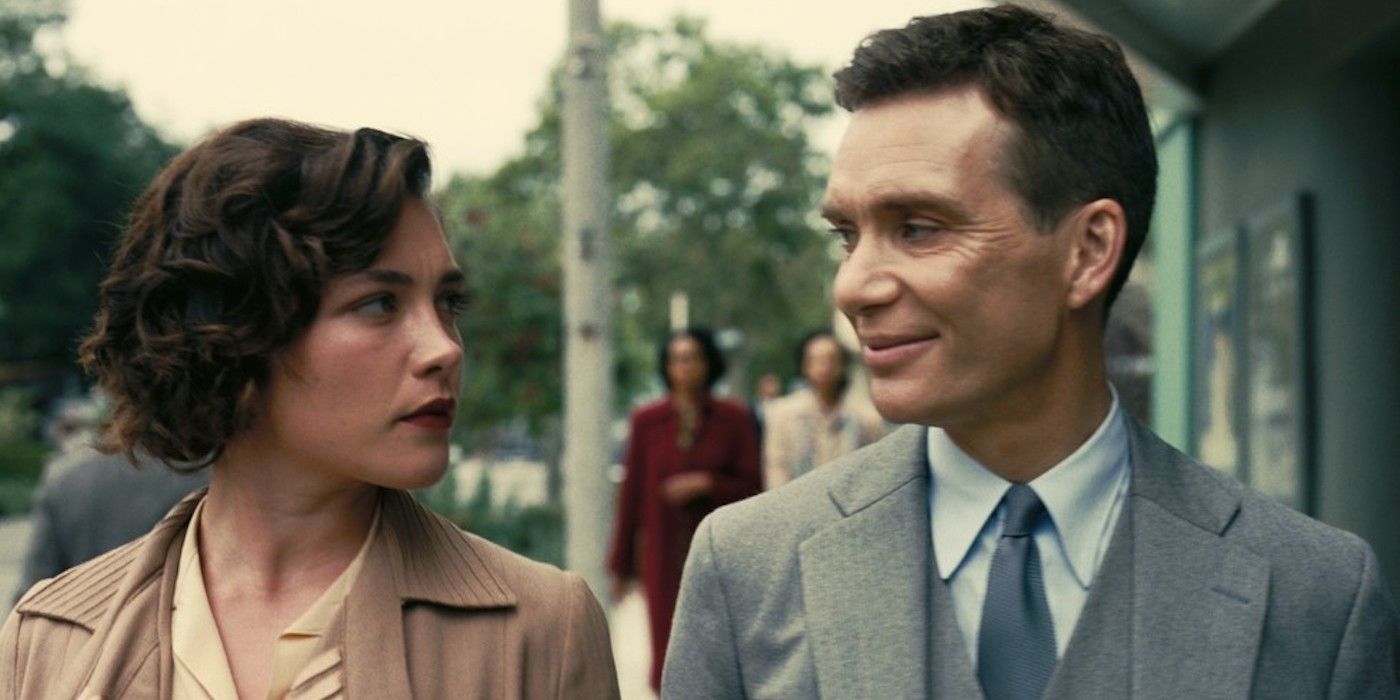Oppenheimer writer and director Christopher Nolan is among a handful of directors determined to draw audiences back to the big screen after the pandemic. In 2018, movies in North American theaters produced a whopping $11.9 billion at the box office, which was the “high-water mark” for the film industry. The following year, the box office brought in a slightly smaller figure of $11.4 billion. However, in 2020, filmmakers and theaters took a massive revenue hit due to the COVID-19 lockdown and social distancing restrictions, dropping 80% to just $2.3 billion, of which $1.8 billion came in during the three months prior to the lockdown in March.
Thankfully, blockbuster hits have slowly started to reclaim theatrical releases (and box office returns) with major titles like Avatar: The Way of Water, Spider-Man: No Way Home, Jurassic World Dominion, and Top Gun: Maverick. On a budget of $100 million, Christopher Nolan decided to create even more mystique and hype surrounding his latest movie, Oppenheimer, by utilizing cutting-edge technology to film with some of the highest-resolution cameras in existence. Oppenheimer, which is Nolan’s longest film to date (Interstellar is the runner-up at 2 hours and 47 minutes), is currently available to watch in the IMAX 70mm format in only 30 theaters worldwide that can support the format. This article will explain what IMAX 70mm means and how it could potentially revitalize how people watch movies in theaters. But first, here’s a video showing the behind-the-scenes process behind Oppenheimer‘s 70mm print:
Editor’s Note: This article was updated on August 13.
What Is The Difference Between 4K Digital and IMAX 70mm Film?
Usually reserved for documentaries like Jane Goodall’s Wild Chimpanzees from 2002, IMAX films have always been considered a visual delicacy, allowing a more immersive experience for viewers. However, filmmakers like Nolan, Kenneth Branagh, and Quentin Tarantino have recently been actively trying to bring the use of 70mm film back to the forefront of the industry.
4K cinema, also known as Ultra HD, has four times the image quality of 1080p HD, with a resolution of 4096×2160 pixels. Compared to 35mm film, 70mm film also boasts a much better resolution, which gives a much more detailed image. 70mm also has a wider aspect ratio than 4K, allowing a more immersive viewing experience. Both formats have advantages and drawbacks, but 70mm is considered the “premium” format providing a more cinematic end-product. Similar to listening to your favorite song via MP3 format, it’s crisp and clean-sounding… but does not compare to the unique authenticity and vibrancy that comes from listening to the same song on an original vinyl record.
There are a lot of pros and cons to consider when deciding between digital and film in terms of photography and, well, filmmaking. While 4K digital cameras are much lighter and less cumbersome than cameras that use film to record, the quality of the film is much more forgiving with small details such as exposure and focus/depth. The film reels from Nolan’s Oppenheimer reportedly weigh 600 lbs, with each containing approximately 11 miles of film footage.
The film also allows for a higher dynamic visual range, specifically capturing details in black-and-white imagery. Additionally (not that cost was that big of a concern for Christopher Nolan), photographers and filmmakers who use real film to shoot must be more mindful of their usage of said film as it can’t simply be erased and filmed over. The cameras used to shoot a movie in 70mm are also very large and heavy, adding to the allure of the convenience of digital cameras. The storage and transportation of the film reels can also be a huge factor, as many theaters can’t support the cost of purchasing and maintaining projectors capable of screening 70mm films. However, the payoff is apparently very worth the extra accommodations, according to some directors. Regarding Oppenheimer, Christopher Nolan stated:
“[The] sharpness and the clarity and the depth of the image is unparalleled. The headline, for me, is by shooting on IMAX 70mm film, you’re really letting the screen disappear. You’re getting a feeling of 3D without the glasses. You’ve got a huge screen and you’re filling the peripheral vision of the audience. You’re immersing them in the world of the film.”
How Many Theaters Have IMAX 70mm?
The capability to support a 70mm formatted film is extremely limited, as the necessary projection equipment is costly to purchase and maintain. As such, there are currently only 30 theaters in the world that can project Oppenheimer in its intended IMAX 70mm format. 19 of those theaters are in the United States, making this viewing experience even more exclusive to American audiences. The projectors and lenses required to project 70mm film are specialized, making it a much more costly investment for theater owners to acquire.
In reference to the specialized equipment, Oppenheimer cinematographer Hoyte van Hoytema told us that:
“As much as we wanted this to be IMAX and part of the IMAX sequences, we realized that we want to shoot a lot of microphotography in IMAX format, [which] doesn’t really have those kinds of possibilities, right? So straight away, we started engineering those specific lenses for the IMAX camera. Effectively, when you do this sort of microphotography, when you want to have a camera, for instance, in between here, or track in between here to enlarge the world of this to sort of a life-size format, you need special lenses. You need what we call probe lenses. They didn’t exist for IMAX, so Dan Sasaki from Panavision built us this pro lens, and we experimented with it, and we improved it, and in the end, it was something that we used a lot for aquarium work and micro work, and macro work. So, that was very exciting.”
What Other Movies Have Been Shot In 70mm Film, and Where Can You Watch Them?
In addition to Oppenheimer, Nolan’s previous films, Dunkirk and Tenet, were also shot in large-format film stock, a combination of IMAX 65mm and Panavision 65mm, and subsequently projected in IMAX 70mm in theaters. Although the format doesn’t necessarily translate to the small screen in the same capacity it would on an IMAX screen at theaters, here are a few examples of other films that have utilized the immersive format you can stream at home!
Death on the Nile (2022)
The sequel to Murder on the Orient Express, directed by Kenneth Branagh, follows the Sherlockian observation and intelligence of Hercule Poirot (played by Branagh) as he investigates the suspicious death of wealthy heiress Linnett Ridgeway-Doyle (Gal Gadot) during her lavish honeymoon cruise in Egypt. This modern murder-mystery movie is available to stream on Hulu, and is available to rent or purchase on Vudu, Amazon Prime, and Apple TV+.
Dunkirk (2017)
Set in 1940, this World War II film (directed by Christopher Nolan) centers around the true events of the Dunkirk evacuation of Allied soldiers in France, after they become encircled by German forces. Starring Fionn Whitehead, Harry Styles, Cillian Murphy, Tom Hardy, Michael Caine, and many other famous names, this movie is available to stream on Amazon Prime with a premium subscription and is also available to rent or purchase on Amazon, Apple TV+, and Vudu.
The Hateful Eight (2015)
Directed by Quentin Tarantino, The Hateful Eight almost serves as a tongue-in-cheek prelude to Antoine Fuqua’s 2016 film, The Magnificent Seven. Not to be confused with Adam Sandler’s The Ridiculous Six, which also came out in 2015, as a loose parody of the cowboy/western drama genre. The Hateful Eight focuses on a mixed group of strangers who have to take refuge inside a haberdashery amidst a brutal winter storm. As always, with Tarantino films, the dialogue and delivery drive the plot in ways that are sometimes hysterical and sometimes terrifying. The Hateful Eight is available to stream on Netflix, and is available to rent or purchase on streaming platforms such as Amazon Prime, Vudu, Google Play, and more.
Source link




